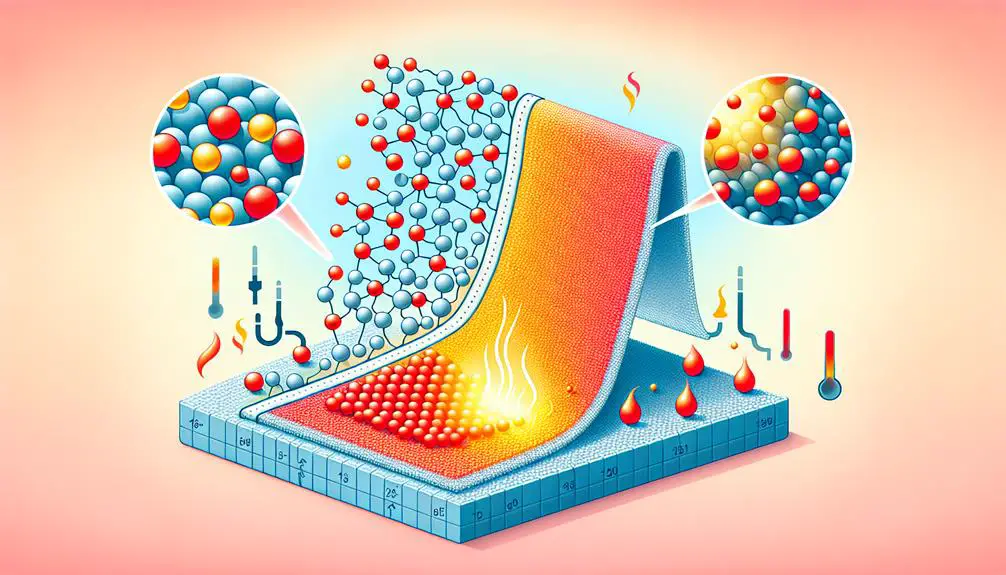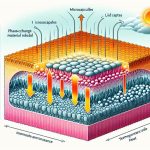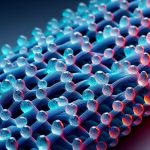Imagine wearing a jacket that can turn the harshest winter into a mild spring day. Phase-Change Materials (PCMs) make this possible by absorbing, storing, and releasing heat to maintain an ideal temperature. You'll find that these materials serve as your personal thermostat, creating a microclimate tailored just for you. But how exactly do these smart fabrics work, and what types of PCMs are out there? Understanding the science behind them could transform the way you think about clothing and comfort.
Table of Contents
Key Takeaways
- PCMs in fabrics absorb, store, and release heat, regulating body temperature for optimal comfort.
- Organic PCMs like paraffin and fatty acids provide versatility, stability, and biodegradability in smart fabrics.
- Inorganic PCMs offer higher thermal conductivity and greater latent heat storage, enhancing durability and cost-effectiveness.
- Smart fabrics with PCMs maintain breathability and flexibility while acting as personal thermostats.
- Future smart clothing innovations may include advanced sensors and bio-based PCMs for enhanced sustainability and functionality.
What Are Phase-Change Materials?
Phase-change materials (PCMs) are substances that absorb and release thermal energy during the process of melting and freezing. You're diving into a fascinating domain where these materials play an essential role in various application areas.
Smart fabrics are one of the most innovative fields utilizing PCMs, offering dynamic temperature regulation. Imagine wearing a jacket that adapts to your body temperature, keeping you comfortable in both hot and cold weather. That's the magic of PCMs at work.
In manufacturing processes, integrating PCMs into fabrics involves embedding microcapsules filled with these substances into the textile fibers. This method guarantees that the fabric retains its flexibility and durability while gaining the ability to manage thermal energy efficiently. Mastering this technique requires a precise understanding of both material science and textile engineering.
You'll find that PCMs aren't limited to clothing; they're also applied in building materials, packaging, and even electronic devices to enhance energy efficiency.
Understanding the application areas and manufacturing processes of PCMs opens up a world of innovation. By mastering these materials, you're not just keeping up with technology—you're setting the pace for future advancements in smart fabrics and beyond.
How PCMs Work
When PCMs absorb heat, they shift from a solid to a liquid state, storing thermal energy in the process. This phase change is the crux of how PCMs enhance fabric functionality. As temperatures rise, the PCM embedded in the fabric absorbs the excess heat, preventing the wearer from overheating.
The material's ability to absorb heat and store energy guarantees a stable temperature for the wearer, providing exceptional temperature control.
You might wonder how this affects the practical use of fabrics in everyday life. The energy storage capability of PCMs means that when the surrounding temperature drops, the stored heat is released as the PCM reverts to a solid state. This release of heat helps maintain a consistent and comfortable temperature against your skin.
This dynamic thermal regulation ensures that smart fabrics equipped with PCMs are highly effective for various climates and activities.
Types of PCMs
When exploring smart fabrics, you'll encounter two main types of PCMs: organic and inorganic.
Organic PCMs, like paraffins, offer flexibility and are non-toxic, while inorganic PCMs, such as salt hydrates, provide higher thermal conductivity and greater heat storage.
Understanding these characteristics and benefits helps you choose the right PCM for specific applications in smart textiles.
Organic PCMs Characteristics
Organic phase-shift materials (PCMs) like paraffin and fatty acids offer versatile and efficient solutions for thermal management in smart fabrics. When you integrate organic PCMs into textiles, you can harness their exceptional thermal properties to regulate temperature effectively. These materials absorb and release thermal energy during phase changes, providing a buffer against temperature fluctuations.
Paraffin, a hydrocarbon-based PCM, is particularly prized for its high latent heat and wide range of melting points. It's an excellent choice for applications requiring precise thermal control.
Fatty acids, another type of organic PCM, offer similar benefits with the added advantage of being biodegradable. They exhibit stable thermal properties, ensuring consistent performance over multiple heating and cooling cycles.
Organic PCMs aren't only efficient but also adaptable. Their integration into fabrics can be achieved through microencapsulation, coating, or blending with fibers. This versatility means you can design smart textiles that meet specific thermal management needs without compromising comfort or aesthetics.
Inorganic PCMs Benefits
Unlike organic PCMs, inorganic phase-change materials offer distinct advantages for thermal management in smart fabrics. They excel in energy efficiency and are particularly beneficial in industrial applications where precise temperature control is essential. These materials, including salts and metals, have higher thermal conductivity and greater latent heat storage capacity compared to their organic counterparts. As a result, they can absorb and release larger amounts of heat, making them ideal for high-performance environments.
Inorganic PCMs also align with green technology initiatives. Their ability to maintain stable temperatures helps reduce energy consumption in various settings, from smart textiles to building materials. This contributes to overall energy efficiency and sustainability, supporting eco-friendly practices.
Here are some key benefits of inorganic PCMs:
- Higher thermal conductivity: Assures faster heat transfer, enhancing the fabric's performance.
- Greater latent heat storage: Allows for more efficient energy absorption and release.
- Non-flammable: Provides a safer alternative for applications requiring strict safety standards.
- Cost-effective: Often less expensive to produce and maintain, making them viable for widespread use.
- Durability: Withstands harsh conditions, extending the lifespan of smart fabrics.
Thermal Regulation Mechanism
Smart textiles utilize advanced materials and technologies to efficiently manage and regulate body temperature. At the core of these smart textiles are phase-change materials (PCMs), which play a crucial role in ensuring thermal comfort and energy efficiency. PCMs absorb, store, and release heat as they shift between solid and liquid states.
When your body temperature rises, these materials absorb excess heat, cooling you down. Conversely, when the temperature drops, they release the stored heat, keeping you warm. You benefit from a consistent microclimate around your body, which greatly enhances thermal comfort.
This process not only makes you feel more comfortable but also reduces the need for additional heating or cooling. By harnessing the thermal regulation properties of PCMs, smart textiles contribute to energy efficiency. You can consider these textiles as your personal thermostat, adjusting to your body's needs in real-time.
Furthermore, the integration of PCMs in smart textiles doesn't compromise the fabric's breathability or flexibility. You get the best of both worlds: advanced thermal regulation without sacrificing comfort or mobility. This sophisticated balance between innovation and practicality is what makes smart textiles truly revolutionary in the realm of wearable technology.
Applications in Textiles
You'll find smart fabrics incredibly useful in various textile applications, especially for temperature regulation.
Imagine your clothes adapting to keep you comfortable in different weather conditions.
These fabrics are also a game-changer for athletic wear, enhancing performance and comfort.
Temperature Regulation Benefits
Temperature-regulating textiles can keep you comfortable by adjusting to your body heat and the surrounding environment. These intelligent fabrics offer numerous health benefits and comfort features, making them ideal for maintaining an ideal body temperature.
By incorporating phase-change materials, these textiles can absorb, store, and release heat as needed, ensuring you're neither too hot nor too cold. This dynamic temperature control reduces the risk of overheating or chilling, which can be particularly beneficial for individuals with health issues sensitive to temperature fluctuations.
Moreover, the energy efficiency of these fabrics can't be overstated. By naturally adjusting to your body's needs, you can minimize the use of external climate control systems, such as heating and air conditioning, hence conserving energy and reducing utility costs. This not only benefits your wallet but also contributes to a more sustainable environment.
Imagine the advantages of intelligent textiles:
- Balanced body temperature: Keeps you warm in cold weather and cool in hot conditions.
- Enhanced sleep quality: Regulates your body heat, promoting restful sleep.
- Energy savings: Reduces reliance on HVAC systems.
- Comfort on the go: Adapts to diverse climates, perfect for travelers.
- Health monitoring: Helps manage conditions sensitive to temperature.
Embrace these innovative textiles to experience unparalleled comfort and efficiency.
Athletic Wear Advantages
Athletic wear made from intelligent textiles enhances your performance by optimizing comfort and functionality. Imagine running a marathon with fabric that actively manages your body temperature, keeping you cool when it's hot and warm when it's cold. These advanced textiles use phase-change materials to provide superior performance enhancement, making your workout more efficient and enjoyable.
You know that comfort is key to maintaining peak performance. Smart fabrics excel in this area by offering exceptional sweat-wicking capabilities. They draw moisture away from your skin, ensuring you stay dry even during the most intense workouts. No more chafing or feeling weighed down by sweat-soaked clothing.
Durability is another significant advantage of these innovative textiles. Traditional athletic wear can degrade quickly with frequent use, but smart fabrics are designed to withstand the rigors of your most demanding activities. They maintain their integrity, keeping you looking sharp and performing at your best over time.
Benefits of PCM Fabrics
Why are PCM fabrics gaining popularity?
The answer lies in their remarkable blend of comfort and sustainability. You'll find that these fabrics adapt to temperature changes, enhancing your comfort level whether you're facing extreme heat or cold.
Imagine wearing a jacket that cools you down when it's hot or warms you up when it's cold. That's the magic of phase-change materials (PCMs).
The sustainability impact of PCM fabrics also can't be overstated. They reduce the need for multiple layers of clothing, thereby cutting down on material usage and waste. This makes them an eco-friendly choice for the environmentally conscious.
Here are some key benefits of PCM fabrics:
- Temperature Regulation: They maintain an ideal temperature range, ensuring you're neither too hot nor too cold.
- Energy Efficiency: By reducing the need for artificial heating or cooling, they contribute to lower energy consumption.
- Enhanced Comfort: The adaptive nature of PCMs means you stay comfortable regardless of external conditions.
- Durability: These fabrics are designed to withstand repeated temperature cycles without losing effectiveness.
- Eco-Friendly: Their ability to minimize material waste means a smaller environmental footprint.
When you consider these benefits, it's easy to see why PCM fabrics are becoming a staple in modern wardrobes.
Future Innovations in PCMs
Building on the impressive benefits of PCM fabrics, let's explore the exciting future innovations that promise to elevate their functionality even further.
Imagine smart clothing that doesn't just regulate temperature but also adapts to your unique physiological needs. Researchers are working on integrating advanced sensors within PCM textiles to monitor essential signs like heart rate and body temperature in real-time. This integration of cutting-edge textile technology will enable your smart clothing to make dynamic adjustments, ensuring prime comfort and performance.
Moreover, the future of PCM fabrics includes the development of more sustainable and eco-friendly materials. Scientists are exploring bio-based phase-change materials derived from natural sources, reducing the environmental impact without compromising on efficiency.
Another intriguing development is the potential for PCMs to interact with other smart systems. Consider clothing that communicates with your smart home or vehicle, adjusting the indoor climate based on your current body temperature.
These innovations in textile technology aren't just futuristic fantasies; they're on the horizon. As you seek mastery in this domain, staying informed about these advancements will place you at the forefront of this transformative era in smart clothing.
Frequently Asked Questions
How Long Do PCM Fabrics Typically Last Before Losing Effectiveness?
PCM fabrics typically maintain their effectiveness for several years, but their durability depends on usage and care. To guarantee longevity, follow care instructions carefully. With proper maintenance, you can maximize their effectiveness and enjoy their benefits longer.
Are There Any Known Health Risks Associated With Pcms?
When considering health concerns with PCMs, it's important to follow safety precautions. Although durability testing guarantees material lifespan, improper handling could pose risks. Always adhere to guidelines to maximize safety and effectiveness.
Can PCM Fabrics Be Recycled or Are They Environmentally Friendly?
You're curious about PCM fabrics' recycling potential and environmental impact. They can be recycled, reducing waste. Their eco-friendly properties depend on the specific materials used, so opting for sustainable options guarantees a lower environmental footprint.
How Do You Care for and Clean Pcm-Integrated Garments?
Caring for PCM-integrated garments is like tending to a prized garden. Follow washing instructions carefully, use gentle drying techniques, and handle stain removal promptly. For longevity, adhere to proper storage tips, ensuring your garments stay pristine.
What Are the Cost Implications of Incorporating PCMS in Textiles?
When considering cost implications, you should focus on cost considerations, market trends, manufacturing processes, and material sourcing. High initial costs might be offset by long-term benefits, aligning with market trends toward advanced, sustainable textiles.







